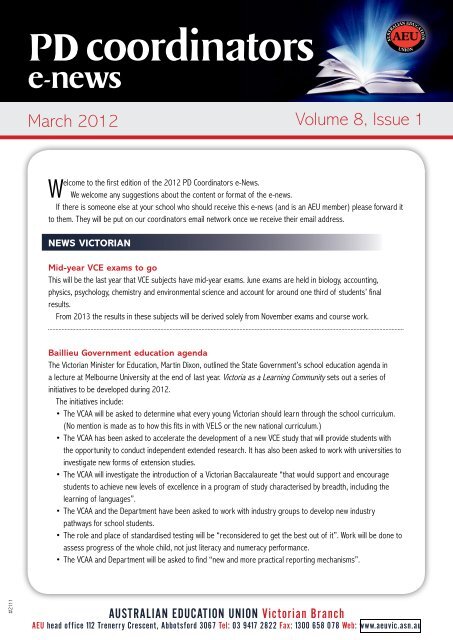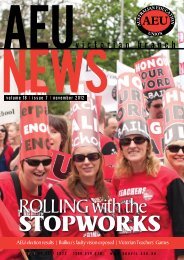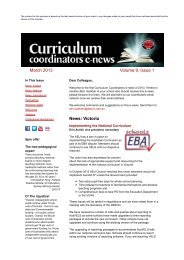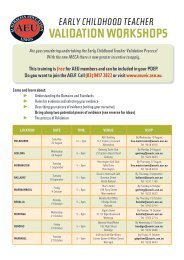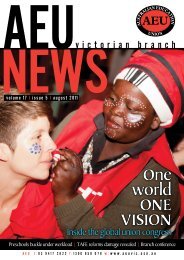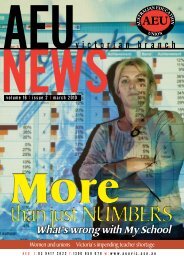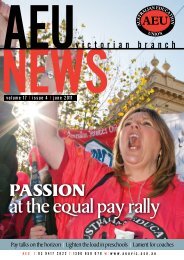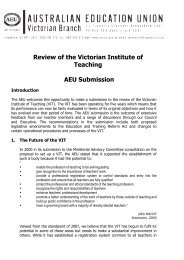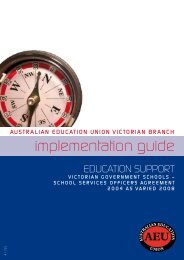PD Coordinators News - Australian Education Union, Victorian Branch
PD Coordinators News - Australian Education Union, Victorian Branch
PD Coordinators News - Australian Education Union, Victorian Branch
- No tags were found...
Create successful ePaper yourself
Turn your PDF publications into a flip-book with our unique Google optimized e-Paper software.
The report calls for an increase in funding across all sectors with the government sector to get the largestproportion due to its size and the concentration of disadvantaged students.The report proposes:• A unified system of recurrent funding for all schools (government and non-government) where all generalrecurrent funds (Commonwealth and state), targeted funding programs and National Partnerships funding arerolled into a single resource standard from 2014.• The national schooling resource standard will have loadings for low SES, Indigenous (with increases for thesetwo groups where the concentration of students is higher), limited English language proficiency, disability,school size and school location.• The resource standard will be developed from an estimation of the costs incurred by schools achieving higheducational outcomes over a sustained period. The initial benchmark will be schools with at least 80% of theirstudents above the national minimum for their year level in reading and numeracy for the three most recentyears of NAPLAN results.• An independent National Schools Resourcing Body will be responsible for constructing the standard andsubsequent annual indexation.• Government schools as “the universal provider” will be fully funded to the resource standard and theappropriate loadings. Non-government schools will receive funding based on their “capacity to contribute” totheir total resource requirements.• Because of the Federal Government announcement that no school will lose a dollar per student with the newarrangements, the minimum public contribution per student for every non-government school (ie for thewealthiest schools) will be set at between 20% and 25% of the schooling resource standard.• Outside of the recurrent funding resource standard, the report calls for an increase in capital funding tosupport major works and infrastructure in government schools.• New cross-sectoral School Planning Authorities will coordinate planning for new schools and school growth.These authorities would assess each new school or school expansion submission in terms of need anddemand in the local area and then decide if funding will be provided from a new School Growth Fund.The report estimates its recommendations will cost (in 2009 prices) an additional $5 billion, 75% of which shouldgo to government schools. It proposes that 30% of the additional funding should come from the Commonwealthand 70% from the states.So far neither level of government has committed itself to the recommendations. The Federal Government hasdecided to have another round of consultation (and indicated that a balanced budget is its first priority) and thestate governments have been somewhere between lukewarm to cool in their responses.Download the Gonski Report (<strong>PD</strong>F) at http://www.deewr.gov.au/Schooling/ReviewofFunding/Documents/Review-of-Funding-for-Schooling-Final-Report-Dec-2011.pdfCertification of Highly Accomplished and Lead TeachersAITSL (The <strong>Australian</strong> Institute for Teaching and School Leadership) released a consultation paper in January on theprinciples and processes for certification of Highly Accomplished and Lead Teachers.Eligibility:• Two satisfactory annual performance assessments for those applying for Highly Accomplished career stage.• Three satisfactory annual performance assessments for those applying for Lead career stage.Page 3 of 16<strong>PD</strong> coordinators e-news | Volume 8, Issue 1 | March 2012
Self-assessment:• A self-assessment tool will be developed.• All applicants must conduct a professional discussion with their principal/supervisor regarding their readinessto apply for certification.The assessment of certification applications has two stages. Applicants must be successful at Stage 1 beforeproceeding to Stage 2.Stage 1:• Assessment of evidence submitted against the seven standards, which includes annotated evidence of teacherpractice, a written statement addressing the standards, at least two observation reports (one of which mustbe by the principal) and referee comments (including those of the principal).• Each of the seven standards must be addressed by at least two pieces of evidence, and each of thedescriptors at the relevant career stage will be accounted for at least once.• For the Lead career stage, the applicant will submit a description of an initiative the applicant has led within theschool or across schools.• Achievement against the standards will be determined through an independent assessment of evidence by twoexternal assessors nominated by the jurisdictional certifying body.Stage 2:• Direct assessment of teacher practice onsite by external assessors which includes observation, discussion withprincipal/supervisor, discussion with other colleagues as required, and discussion with applicant.• The site visit must include: observation of one session/two periods (or equivalent) of classroom practice anddiscussion with the principal/supervisor to further explore the performance of the applicant against the standards.Following the site visit, the assessor who conducted the visit will report back to the other assessor involved in Stage1. They will arrive at a consensus decision on whether the applicant meets all seven standards at the relevantcareer stage.The AEU expressed concern to AITSL at the disconnection between these national higher career categories(and the proposed measures of assessment and certification) and the salaries and career structures within whichteachers work.The AITSL plan to have a certification process as a matter of purely professional recognition — separate anddistinct from the industrial and employment context — will limit the participation of teachers in that process.The AEU is also concerned about the hierarchical nature of what is being proposed (principal as the gatekeeper)as the national career categories were supposed to be based on a professional model of recognition andcertification.Teach NextThe Federal Government allocated $15.9 million in its 2011–12 budget to introduce a new employment-basedpathway into teaching.The purpose of the scheme is to address shortages in regional and hard-to-staff schools and in areas ofcurriculum need and “reduce the number of teachers currently teaching outside their subject areas”.The funding will pay for up to 395 professionals from other employment areas to make a career change andbecome teachers. Participants will undertake a two year post-graduate Diploma in Teaching while they areemployed in a government or a non-government school on an 80% teaching load.Page 4 of 16<strong>PD</strong> coordinators e-news | Volume 8, Issue 1 | March 2012
Bureaucratic name changeIn 2011 the Council of <strong>Australian</strong> Governments (CoAG) announced the launch of the Standing Council on School<strong>Education</strong> and Early Childhood (SCSEEC). The Standing Council replaces the Ministerial Council for <strong>Education</strong>, EarlyChildhood Development and Youth Affairs (MCEECDYA).INTERNATIONALFrom My School to My TeacherIndividual performance rankings of 18,000 New York teachers were released by the New York City <strong>Education</strong>Department and published by the New York Times in late February. The information was acquired through FOI afterthe United Federation of Teachers failed in its legal efforts to block its release.The “Teacher Data Reports” name each teacher and their school and then rank them based on their students’gains on the state English and maths tests over three school years up until the 2009–10 school year.The reports are a form of “value-added assessment” supposedly showing the value individual teachers add bymeasuring how much their students’ test scores exceeded or fell short of expectations based on demographics andprior performance.The ratings cover teachers in Grades 4–8 (where the state tests are held) and there were separate reportsfor English and maths. The ratings were distributed on a statistical curve so that 50% of teachers were ranked“average”, 20% above or below average and 5% “high” or “low”.There were many specific concerns about the rankings:• A huge margin of error around each rating of 35 percentiles in maths and 53 percentiles in English.• Some teachers were judged on as few as 10 students.• The data is two years out-of-date and teachers may no longer teach particular grades or at particular schoolswhere they are rated.• Some teachers were rated on courses and grades they had not actually taught.• Some teachers were rated on students they had not actually taught.• Wide variations in yearly ratings of teachers who taught the same grade the same way over the three years.• They will become a permanent assessment of teachers’ careers, whether accurate or not.• The ratings will be used to calculate at least 20% of the overall score on a new state teacher evaluationscheme. Two years of poor ratings could lead to dismissal.Rating teachers has been pushed along by the Obama administration through its Race to the Top initiative. When in2010 the Los Angeles Times produced the first set of teacher ratings in a US city, the US Secretary of <strong>Education</strong>,Arne Duncan, praised the newspaper saying “Silence is not an option”.http://www.nytimes.com/schoolbook/tag/teacher-data-reports/page/2/http://www.nydailynews.com/new-york/york-city-teacher-ratings-unreliable-educators-warnedarticle-1.1041958New York’s “worst” teacher houndedWithin hours of the publication of the Teacher Data Reports (TDRs) [see previous story] teachers and their familieswith low scores were being hounded by news reporters from the New York Post.The newspaper zeroed in on a sixth grade teacher, Pascale Mauclair, who teaches small classes of recentlyPage 6 of 16<strong>PD</strong> coordinators e-news | Volume 8, Issue 1 | March 2012
focused supports for teachers’ subject matter knowledge, knowledge of children’s mathematics and implementationof reform-oriented pedagogical practices”.In another study involving <strong>PD</strong> in maths, teachers learned about mathematics content and pedagogy in theCognitively Guided Instruction (CGI) program.Teachers learned about CGI strategies, studied mathematics curriculum together, looked at student learning, anddeveloped a unit and a year-long plan involving CGI instruction.CGI operates on the theory that if teachers understand how students think and learn, they can better predictwhat their students need and match instruction accordingly.The researchers found that, in comparison with control-group teachers, CGI teachers more often emphasizedproblem-solving skills, listened to students, expected students to use multiple strategies, and had greaterknowledge of students’ thinking.In comparison to control-group students, students in CGI classrooms demonstrated higher level problem solvingabilities and greater recall of number facts, while performing comparably on basic skills tests.Taken together, these studies illustrate the importance of sustained, content-focused professional developmentfor changing practice in ways that ultimately improve student learning.[From Professional Learning in the Learning Profession, R. Chung Wei, L. Darling-Hammond, A. Andree, N. Richardson and S. Orphanos, School Redesign Network at Stanford University, 2009]http://www.learningforward.org/news/NSDCstudytechnicalreport2009.pdfTeacher collaboration worksA new research study identifies teacher collaboration as the key to improving student achievement.University of Pittsburgh professor Carrie Leana studied more than 1000 Grade 4 and 5 New York City publicschool teachers over two years and examined changes in student achievement scores in maths.She found that encouraging teacher collaboration and teacher stability is more likely to improve student learningthan ramping up the number of better trained, more gifted, and more motivated teachers.“When the relationships among teachers in a school are characterised by high trust and frequent interaction —that is, when social capital is strong — student achievement scores improve,” writes Leana.“In many schools, such social capital is assumed to be an unaffordable luxury or, worse, a sign of teacherweakness or inefficiency. Yet our research suggests that talking to peers about the complex task of instructingstudents is an integral part of every teacher’s job and results in rising student achievement.”Source: Leana, C. (2011, Fall). The missing link in school reform. http://www.ssireview.org/articles/entry/the_missing_link_in_school_reformStanford Social Innovation Review, www.ssireview.org.Decline of Professional Learning in Primary SchoolsThe Staff in Australia’s Schools survey results for 2010 indicate a decline in the national levels of <strong>PD</strong> inprimary schools from 2007 to 2010. (For more information on the survey go to the Statistics section of the <strong>PD</strong><strong>Coordinators</strong> e-news.)Page 8 of 16<strong>PD</strong> coordinators e-news | Volume 8, Issue 1 | March 2012
Professional learning in primary schoolsCurrently teaching in this area Prof learning in past year in this area 2007 (%) Prof learning in past year in this area 2010 (%)Literacy 69.3 63.9Numeracy 57.7 52.8LOTE 55.4 41.5Computing 48.6 36.5PROFESSIONAL DEVELOPMENTAEUAEU training, conferences and eventsThe AEU runs a large number of conferences, industrial and professional training sessions and member forums. Afull list of these activities, dates/times and venues can be found on our website. You will also be able to book youractivity online.http://www.aeuvic.asn.au/trainingThe 2012 AEU Events Calendar can be read online or downloaded at: http://www.aeuvic.asn.au/eventsAEU Active for Principals — Thursday 21 JuneThis one-day <strong>PD</strong> for aspirant principals, assistant principals and newly appointed principals focuses on leading andmanaging in the context of the VGSA. If you can get the technical leadership of a school right, then you will havemore time for educational leadership. Issues include human resources, workforce planning and consultation andselection. Attendees will receive a copy of the TLN Press book, Wisdom and Action: A Leadership Handbook.Legal Liability LIVE & ONLINE — Tuesday 8 MayDuty of care, yard duty, ES supervision of students, Facebook —what we should and shouldn’t do as teachers, ESand principals. This forum is designed to give information, examples and answers. Participants can attend in personor join in online. This <strong>PD</strong> can also be run in your workplace.Women’s Conference — Saturday 26 MayThe AEU Women’s Conference is one of the major <strong>PD</strong> events of the union’s year, addressing women’s issuesin Australia and around the globe, and offering a full range of workshops for your personal and professionaldevelopment. This year’s conference will focus on the situation for women and girls in the developing world and ourresponsibility and response.Primary Graduates Conference — Friday 11 MayThis conference for graduate teachers working in the primary sector offers great <strong>PD</strong> for members andnon-members of up to three years’ experience. It includes workshops of particular relevance to beginning teachersand keynote addresses on current professional and industrial issues.Secondary Graduates Conference — Friday 25 MayThis conference for graduate teachers working in the secondary sector offers great <strong>PD</strong> for members andPage 9 of 16<strong>PD</strong> coordinators e-news | Volume 8, Issue 1 | March 2012
non-members of up to three years’ experience. It includes workshops of particular relevance to beginning teachersand keynote addresses on current professional and industrial issues.Casual Relief Teacher (CRT) Conference — Thursday 12 April: Technology in the classroomCRTs face particular issues, whether they work in public or private schools. This joint AEU/IEU conference offersa full day of professional development and networking for teachers who often miss out on the training andopportunities to share good practice enjoyed by other teachers. Open to non-members. You can also participateonline. Register at www.tln.org.auRefresher Course: Returning to work — Monday 18 JuneThis one-day workshop is for teachers returning to government schools after a prolonged absence such asfamily leave. It covers current DEECD and government policies and initiatives, including the National Curriculum;employment conditions; returning to the classroom — what has changed; classroom management; andRecruitment Online and job applications. The day runs from 9am—4pm. Morning tea and lunch provided. Registerwith rhonda.webley@aeuvic.asn.au or on 9418 4844.All of the above <strong>PD</strong> events will be held at the AEU Building, 112 Trenerry Crescent, Abbotsford.AEU K-6 Annual Conference, 17 and 18 AugustAll members — teachers, principals and support staff — are invited to join us for our annual K-6professional conference on Friday 17 and Saturday 18 August. This year’s theme is Quality: building,achieving and celebrating the best of what we do. Keynote speakers include Dan Gregory (ABC1’sThe Gruen Transfer) and early childhood advocate Anthony Seaman. Great value at $55 for oneday or $85 for both days. For more information and to register: http://www.tln.org.au/index.php?option=com_dtregister&Itemid=2&eventId=138&controller=event&task=individualRegister.<strong>Victorian</strong> <strong>Education</strong>al Leadership Consortium (VELC)Applying for Leading Teacher Positions — 2012• May 2• July 18• September 5• October 10The Applying for Leading Teacher Positions workshop assists aspiring teacher leaders to recognise their strengthsand skills and helps them to translate these into effective application writing and interviews, while making links withtheir own daily practiceApplying for Principal Class Positions• May 14• July 25• September 10• October 22Page 10 of 16<strong>PD</strong> coordinators e-news | Volume 8, Issue 1 | March 2012
The Applying for Principal Class Positions workshop assists principals, assistant principals, aspirant leaders andteacher leaders to articulate a personal response to leadership and develop their application writing and interviewskills with particular reference to the new guidelines.All of these workshops are Melbourne-based and will be held at:AEU Building112 Trenerry Crescent, AbbotsfordAll enquiries or registration for the above workshops should be directed to Mary O’Hagan, (03) 9418 4967 oremail mary.o’hagan@aeuvic.asn.auTeacher Learning Network (TLN)The TLN has a full program of professional development workshops available to teachers in all DEECD schools. Ifyou have not received TLN brochures for courses in 2012 call the office on 9419 4992 or go to www.tln.org.aufor the full list of workshops and activities.For School LeadersLM203 Leadership and Emotional Intelligence — Tuesday 8 MayFor many years and particularly since the ground breaking work of Daniel Goleman, we have understood theimportance of emotional intelligence. In this workshop, Kerryn Vellerman, new to the TLN leadership team in 2012,will introduce you to ideas about how you can become a more effective leader by understanding and developingyour own emotional intelligence and strategies for enabling your own team to work more effectively. At the AEUbuilding on Tuesday 8 May.Click here for more details and to register LM203.Free <strong>PD</strong> — online opportunities for TLN member schoolsDon’t forget that as a TLN member school you can now access more than 25 online programs covering teachingpractice, leadership and behaviour management — FREE. Have staff members try any or all of the following (clickon the link to register):TH205 ‘Building Resilience’ with Maria Ruberto Thursday 26 AprilTH207 ‘Introduction to Restorative Practice’ with David Vinegrad Thursday 3 MayEpilepsy Foundation of VictoriaNew for 2012Understanding and Managing EpilepsyWorkshop for primary/secondary teachersCamberwell, Friday 18 May, 2pm–4pmThe first part of the workshop focuses on what epilepsy is, the possible impact on students with epilepsy andhow to support the student should a seizure occur at school. In the second half the focus is more on the learningimplications, development of Epilepsy Management Plans, and strategies to support students.This training is targeted to all school staff such as teachers, integration aides and support staff.Please contact the Epilepsy Foundation of Victoria for further details & registration on (03) 9805 9111.Page 11 of 16<strong>PD</strong> coordinators e-news | Volume 8, Issue 1 | March 2012
Several other workshops are planned across Melbourne /Bendigo /Geelong Regions in Term 2.Student-specific epilepsy training can be delivered at individual schools (1.5hrs) — to arrange a staff <strong>PD</strong> pleasecontact Janita Keating, <strong>Education</strong> and Training Manager on (03) 9805 9170 (direct) or 0427 612310 (mob).RESEARCH DIGESTOECD PublicationsPreparing teachers and school leadersPreparing Teachers and Developing School Leaders for the 21st Century was written as a background report forthe March 2012 International Summit on the Teaching Profession.The report provides a summary of research about school leadership development, the changing agenda forteaching, teacher <strong>PD</strong>, employment conditions, initial teacher education and the supply and demand of teachers.Interesting data include comparisons between countries about the levels of autonomy schools have overcurriculum and assessment. Two places to which Australia is now being compared (because of their highperformingschool systems) are Finland and Shanghai-China.The following table represents the percentage of principals who indicated that each issue was determined byprincipals/teachers only without central/regional authority having a say.Australia (%) Finland (%) Shanghai-China (%)Establishing student assessment policies 65 50 86Choosing which textbooks are used 92 98 49Determining course content 46 32 45Deciding which courses are offered 75 55 52The report includes a description of the system of initial teacher education in Finland:• Pre-service teachers are required to write a research-based thesis as the final requirement for their normalqualification — a masters degree. This prepares teachers to engage in disciplined inquiry in the classroom.• The courses emphasise subject-specific pedagogy, diagnosing learning difficulties and adapting teaching tovarying student learning needs and styles of learning.• Students have a year of school-based experience in university-linked schools which are expected to modelinnovative practices and foster research on learning and teaching.http://www.oecd.org/dataoecd/4/35/49850576.pdfSchool choice and equityA recent OECD study — School Choice and Equity (2012) — found that Australia has the highest degree of schoolchoice of any OECD country. Ninety per cent of students are in secondary schools where principals report that theycompete with two or more schools, compared to the OECD average of 60%. Finland as a high quality, high equitycountry has only 43% of its schools in this situation.The combination of policies promoting school choice and significant private school subsidies (which characterisesthe <strong>Australian</strong> schooling system) is described by this OECD study as the policy setting most likely to encouragePage 12 of 16<strong>PD</strong> coordinators e-news | Volume 8, Issue 1 | March 2012
Percentage of secondary schools with difficulties in filling vacancies (2010)High SES...........2.8%Medium SES.......9.2%Low SES............15.1%The full report can be found at http://www.deewr.gov.au/schooling/documents/siasmainreport.docxREPORTS AND INQUIRIESGrattan Institute Report: “Catching Up”Two days before the landmark Gonski Review published its report into school funding, the Melbourne GrattanInstitute published its own report (Catching up: Learning from the best school systems in East Asia) about how<strong>Australian</strong> schools were falling behind those in East Asian countries.The report describes the school systems in Hong Kong, Korea, Shanghai and Singapore. It chose these cities andcountries because they outperformed Australia in international testing and, with countries like Finland and Canada,are at the top of the OECD PISA international testing league tables.The report plays down the provision of resources and the effect of culture on the performance of these Asian“countries”. Instead their high performance is ascribed to “a relentless, practical focus on learning, and thecreation of a strong culture of teacher education, research, collaboration, mentoring, feedback and sustainedprofessional development”.In Australia, the report contends, there is a disconnection between the attempt to introduce similar policies andtheir impact in the classroom. The report claims to show how the success of the Asian cities and countries can beemulated by breaking down this disconnection.The Grattan report arose out of a “round table” conference in Melbourne in September 2011, sponsored bythe <strong>Victorian</strong> Department of <strong>Education</strong>. The round table was attended by representatives from the four East Asianeducation systems, the <strong>Australian</strong> Prime Minister and Federal Minister for <strong>Education</strong> and education departmentheads from around the country.The arrival of the report a day or so before the release of the Gonski Review findings looked like a case of“ambush marketing”. The media pounced on the Grattan report because it seemed to offer a low cost alternative tothe $5 billion Gonski bill.The report can be found at http://www.grattan.edu.au/pub_page/129_report_learning_from_the_best.htmlPUBLICATIONSAEUProfessional Voice — Equity and DisadvantageThe new edition of Professional Voice on the theme of “Equity and Disadvantage” is now ready to be published.The writers — from <strong>Victorian</strong>, national and international backgrounds — cover a broad range of issues related tothis theme:Editorial: The reproduction of disadvantage by John GrahamEquity and the Simplification of National Policy by Alan ReidRescuing from the Darkness: Equity and the early years by Tony VinsonPage 14 of 16<strong>PD</strong> coordinators e-news | Volume 8, Issue 1 | March 2012
Victoria’s Third Wave: The Coalition and state education reform by John GrahamWhat’s Wrong with this Picture? <strong>Australian</strong> policy views of educational disadvantage by John SmythUnintelligent Design: Why systems matter by Alan SmithersPreschool Teachers’ Strategies for Supporting Resilience in Early Childhood by Ann Taket, Karen Stagnitti, AndreaNolan and Siobhan CaseyFrom Teacher’s Questions to Students’ Questions by Dan Rothstein and Luz SantanaLinda Darling-Hammond on teacher education, Teach for America and professional standards an interview by JohnGrahamHard copies of Professional Voice will be mailed to all members of the AEU Curriculum and <strong>PD</strong> Coordinatornetworks. The journal is free to AEU members. It is also available on the AEU website.Teacher Learning NetworkPublications to support your work in the classroomDon’t forget to check out the full range of publications from TLN Press — go to www.tlnpress.org.au to order AndGladly Teach, Wisdom and Action, The Music Cubby.VCAL Teachers — look for the full range of Work Right resources — most are free. Go to http://teachworkright.com/Coming in the first week of March — Glen Pearsall’s new publication, Classroom Dynamics — A Teacher’sHandbook, an exciting companion to his best-selling And Gladly Teach (now in its third reprint). Pre-order yourcopies of the new book from admin@tln.org.au. Recommended retail price is $19.99 but will be available to TLNmembers for just $16.00 per copy (+ postage and handling).SPIN OFFSThe Gonski recommendations — on the right track?A considered response from WA“This is the Commonwealth saying we want your money, we want to pool it, and we now want toadminister state government schools. Sorry ain’t gonna happen,”— Colin Barnett, WA Premier, The Age, 23/2/12Pyne sees through it all“The Gonski education proposals released today potentially place all non-government schools on aprivate school hit-list.”— Christopher Pyne, shadow Minister for <strong>Education</strong>, media release, 20/2/12So does Barnaby“So Mr Gavrielatos of the teachers’ union should just fess up and be straight with us. Is $5 billion reallygoing to make you happy or is your ultimate goal to take choice away from the <strong>Australian</strong> parents’ desirefor the future of their children?”— Barnaby Joyce, National Party senate leader, Canberra Times, 23/2/12Page 15 of 16<strong>PD</strong> coordinators e-news | Volume 8, Issue 1 | March 2012
While Peter is amazed by the low cost alternative“The Grattan Institute’s excellent report on high performing education systems in this region… is morethan interesting, you might say it is amazing.”— Peter Garrett, Federal Minister for School <strong>Education</strong>,quoted in endorsements for the Grattan Report on the Grattan Institute website, 23/2/12Page 16 of 16<strong>PD</strong> coordinators e-news | Volume 8, Issue 1 | March 2012


